
Conference Day: Day 3 – November 3rd 2017
Speakers: Martha Crago, Vice-Principal Research and Innovation, McGill University; Art McDonald, Professor Emeritus, Queen’s University, Nobel Laureate (Physics 2015); David Naylor, Professor of Medicine and President Emeritus, University of Toronto; Rémi Quirion, Chief Scientist of Quebec
Takeaways and recommendations:
Panelists discuss government reaction to report and offer advice on next steps
The Fundamental Science Review (FSR) has triggered a chain of events that could significantly transform government’s approach to research and innovation, including how it implements new programs and organizations designed to maximize the impact of Canada’s scientific community.
Since the report’s release in April, the government has created an Office of the Chief Science Advisor, a Canada Research Coordinating Committee and revamped the Canada Research Chairs program. At the same time, work continues on establishing a National Advisory Council on Research and Innovation (NACRI) to replace the Science, Technology and Innovation Council.
Prepared by the Advisory Panel on Federal Support for Fundamental Science, the report has also energized researchers from coast to coast, particularly many early career researchers, to lobby the government to act on all 35 of the panel’s recommendations as an integrated package.
The Canadian Science Policy Conference organized a plenary session to assess progress to date on the FST report, and what challenges to expect in the run-up to the next federal Budget, due in early 2018. Dr. David Naylor, the chair of the FSR panel, said that governance improvements were essential to ensure accountable and effective use of new funds, but had a message for decision-makers in Ottawa:
“There is a demonstrated, benchmarked urgent need for a major multi-year boost to funding for science … Please don’t even think justifying further delay in investment on the grounds of inadequate governance and accountability.” He emphasized, however, that “NACRI is an urgent need. There’s no overarching body trying to make sense of things … We also need to set priorities better than we do now.”
Nobel laureate Dr. Arthur McDonald and FSR panel member singled out the diversity challenge facing Canadian research and the need for early-career researchers “to have access to new money”. He said boosting funding for the granting councils would have a positive impact.
McDonald also supports the FSR recommendation that Canada Foundation for Innovation support for successful research infrastructure projects be increased from 40% to 60%, adding that the ultimate sharing ratio should be determined by local impact. If a facility is primarily national in scope, he said it’s an undue burden on local institutions to have to find 60% of its cost.
“The fact that (Science minister Kirsty Duncan) has mentioned these problems, I’m very hopeful that that’s another of the recommendations that will be considered seriously by the government,” said McDonald.
Fellow panel member Dr. Rémi Quirion said the recommendations should be responded to as a totality, and cautioned against cherry picking some recommendations over others.
“That’s when Canada could get a lot of payback – international partnerships, larger strategic initiatives, training of the next generation of scientists, money for investigators,” said Quirion. “We need to keep that as a global ecosystem – it should be seen as an ensemble, as a puzzle you want to solve.”
Dr. Martha Crago agreed that more money is essential to support early career researchers. Currently more than half of granting council funding flows through to graduate students.
“If you want the future you have to invest in these graduate students (and) I think we overlook that and (the fact that) 50% of graduate students are women now,” she said.
Naylor said that better governance and more funding were both important to improving diversity and inclusion. Supporting young research talent was crucial because “the new generation of researchers looks a lot more like Canada than the generation to which the four of us (panelists) belong”. Accordingly, any new investments should be accompanied by “some built-in focus on bringing along the trainees and students” and “supporting early-career researchers”, thereby ensuring that diversity and equity considerations were addressed.
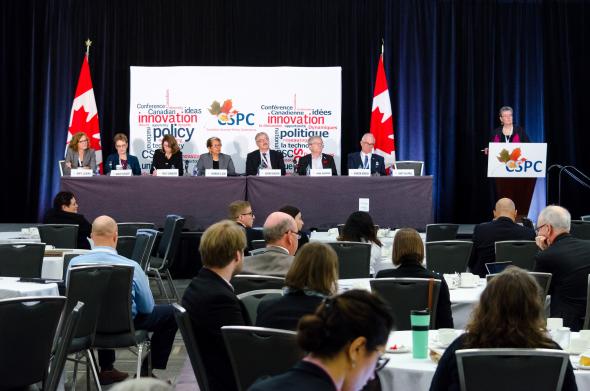
Conference Day: Day 3 – November 3rd 2017
Organized by: Gordon McBean and Anne Ballantyne | International Council for Science and Centre for the Study of Science and Innovation Policy (CSIP), JSGS, and University of Saskatchewan
Speakers: Charmaine B. Dean, Vice President Research, University of Waterloo; Margot Hurlbert, Lawyer, Professor, Johnson Shoyama Graduate School of Public Policy, University of Regina; Jerome Konescni, Executive-in-Residence, Johnson Shoyama Graduate School of Public Policy, University of Saskatchewan; Amy Luers, Executive Director, Research for Global Sustainability Programme, Future Earth; Rémi Quirion, Chief Scientist of Quebec; Peggy Schmeiser, Associate Director and Co-founder, Centre for the Study of Science and Innovation Policy
Moderator: Gordon McBean, President, International Council for Science
Discussant: Janet Halliwell, Principal, JE Halliwell Associates Inc.
Takeaways and recommendations:
- All stakeholders need to recognize the importance of working across scientific disciplines and in partnership with policymakers, civil society and industry to develop evidence-based policies that address “wicked” problems related to the management and sustainability of environment, natural resources, health and economic systems. The World Economic Forum’s 2017 Global Risks assessment put extreme weather events, natural disasters and large-scale involuntary migration as 3 of the most likely high impacts risks and linked these and others to governance failures at the global to national levels.
- Transdisciplinary research needs to be multi-sectoral, multi-dimensional and have multi-level governance. Internationally, the International Council for Science and the International Social Sciences Council are merging to create the International Science Council, for all sciences, to address the global challenges and to advance all sciences as a global public good. Transdisciplinary research should:
- Be guided by a clear identification of the problem being addressed.
- Integrate the social and human dimensions, bridging cultural, linguistic and methodological differences.
- Recognize the different time lines of policy (short) and research (long).
- Engage all players, researchers and partners, at the beginning, not as an add-on.
- There should be an integrated approach to tackling global issues at international, national and local levels.
- Canada needs to be more involved in in important international groups (e.g. new International Science Council; Paris climate accord; UN Sustainable Development Goals; Sendai Framework for Disaster Risk Reduction; the New Urban Agenda; Global Development Network’s Global Research Agenda).
- Consider creating a Canadian national committee for integrated science involving all levels of government, indigenous communities, private sector and academia.
- Institutions can play a leadership role in fostering cross-disciplinary collaboration and the inclusion of non-traditional partners in research.
- The three ingredients for an effective science-policy/society interface are:
- People: The research needs to address the needs and values of diverse stakeholders. Establishing those stakeholder networks is critical. Partnerships in research must be built on trust and solid, ongoing relationships.
- Problem: Researchers tend to start with questions. Instead, start with the problem you want to address, and then frame the research questions around that problem.
- Process: How knowledge is produced and how it is transmitted in society. For example, Future Earth is developing Knowledge Action Networks of people across disciplines and across sectors who focus on solving problems that matter to society. This is done through workshops and meetings, and co-designing and co-creating research and innovation agendas.
- Overall – tackling wicked problems requires new ways of thinking and new ways of working, with a commitment to co-design and co-development of research and policy.
Case study: Future Earth
- Future Earth, a global research program aimed at accelerating transformations to
global sustainability through research and innovation, is experimenting with new processes that bring together stakeholders from various sectors to co-design research projects on how climate and global environmental change might influence human security in the future. The goal is to build enduring collaborative networks.
- Future Earth has a secretariat with Global Hubs in Montreal, Paris, Stockholm, Tokyo and Boulder, Colorado, and works with teams of scientists from around the world and across 20 core research projects and now a dozen Knowledge Action Networks.
- Work is needed to bring aboard southern countries as the negative impacts of climate and environmental change will disproportionately affect the south.
- Montreal ’s Global Hub has strong backing from the Quebec government and City of Montreal. However, more funding is needed from the Canadian government for support for Canadian scientists across all disciplines to participate as researchers in the global research program.
Case study: Innovation Saskatchewan
- Innovation Saskatchewan (IS) advises the Saskatchewan government on the R&D, demonstration, and the commercialization of new technologies. It was tasked with developing an innovation strategy that would be integrated into the Saskatchewan Plan for Growth.
- A Jurisdictional Advantage Assessment was undertaken to provide both IS and the provincial government with an evidence-based approach for making defendable innovation investment decisions that were environmentally and economically sustainable. The assessment identified three core engines that would have the biggest long-term impact on the province’s economy: agriculture; oil and gas; and mining and minerals.
- The strategy also needed to address food security, societal issues, health issues and climate change. Government, industry and academia partnered to develop institutions that take a multidisciplinary approach to those global issues: International Minerals Innovation Institute, Global Institute for Food Security, Petroleum Technology Research Centre and the Sylvia Fedoruk Canadian Centre for Nuclear Innovation.
- Challenges associated with these institutional models included:
- Competitiveness, confidentiality, intellectual property, and trust made information sharing, project selection and extension difficult.
- Metrics need improving. (e.g. It is difficult to get industry to share competitive data.)
- Consensus on priorities and strategies often difficult to achieve between government, industry and academia.
- Political timelines for outcomes need to be managed.
- The benefits of these institutional models included:
- Industry investment was mandatory and industrial leadership was built into governance model. Thus, industrial relevance and utilization of research was assured.
- Programs and research were based on industrial priorities in collaboration with partners.
- There was good leverage of government funds.
- Social scientists need to be engaged earlier in development of these programs, and with adequate resources, to address issues of social responsibility and the resulting ‘social licence’.
Case study: GEOIDE Network
- The GEOIDE Network (1998-2012) was a tri-council funded national Network of Centres of Excellence that assembled researchers from geomatics, environmental sciences, engineering, public health and the social sciences, as well as government, industry and communities partners.
- One project developed analytic tools to study and manage Canada’s forests, particularly in mitigating forest fires. The project team included was wide and varied (e.g. indigenous communities, climate and atmospheric scientists, ecologists, insurance companies, lumber companies, firefighters, etc.). The project’s strength’s included:
- That the problem had clear social impact and team members were passionate about solving the issues; they valued the social and scientific contributions of the team’s research as well as how the research contributed to enhancing each team member’s research agenda
- That team members were committed to creating novel solutions and to understanding the different perspectives at the table, rather than utilizing their favourite research hammers and tools they worked together to create new ones specific to the issue
- Recognizing the importance of bridging the timing gap; research and technology development operate on a different timescale than policymakers need.
- Training workshops were held to ensure all participants understood the variety of perspectives at the table and therefore had greater insight into the problem being addressed and what types of solutions would be required as well as which ones would be unacceptable.
- Top-level support from government bureaucrats and elected officials.
- Approaches that proved successful included:
- dedicated leadership with all stakeholders engaged from the start
- agreement on goals (science and policy goals should align)
- evaluations that recognize the efforts of researchers and other team members
- identification of potential tension
- commitment to communication
- examination of the problem from a variety of perspectives
- communicating impact in ways that are relevant to decision-makers
Case study: The academy and big science
- Large research facilities or major science initiatives and the huge investments that keep them running are part of the policy mix for governments looking for solutions to complex problems. But they cannot solve these problems alone.
- In a recent study at four Canadian universities entitled, “Collision and Convergence: Assessing and Maximizing the Mutual Benefits of Collaboration between ‘Big Science’, Social Sciences and the Humanities” (publication pending), natural science participants spoke the most often about collaboration across disciplines. The most cited disciplines for collaboration with big science were the combined fields of arts music, drama, journalism and writing.
- Barriers to collaboration include:
- Funding and resource limitations
- A perceived disconnect between science and culture, society and humanities
- Negative attitudes or lack of interest’ “researchers should humbly admit that their own disciplines don’t have all the answers”
- Enablers and suggestions to support collaboration include:
- An interest and willingness to collaborate (social scientists, humanists and administrators)
- Education and outreach programs (natural scientists)
- The right environment and language that cuts across disciplines
- Funding and resources
- Reaching out and learning from other disciplines
- Recommendations include:
- public policies and funding should reflect broad holistic approaches to problems and not just focus on industrial or economic impacts
- new researchers must be trained to respond to complex policy questions that build on diverse modes of thinking
- science facility governing bodies should include members from across the academy
- access fees and criteria should be adapted to encourage non-traditional users
- spaces are needed for diverse researchers to gather and imagine new ways of thinking
- tenure and promotion should recognize multidisciplinary collaboration
- Examples of successful models include:
- TRIUMF’s collaboration with artists
- Training opportunities for criminologists and forensic scientists at NEPTUNE Canada
- The connection to northern communities for sociologists and health professionals enabled by the Amundsen research icebreaker
- Going forward, initiatives will need to recognize that researchers from the social science and humanities (SSH) fear being treated as add-ons to what is often viewed as the more important foundational work of big science.
Case study: Collaborative science and climate change
- As a first step, develop a robust conceptual framework that integrates researchers from diverse disciplines while recognizing each science’s differences and limitations.
- Include scientists skilled in interdisciplinary and transdisciplinary science.
- Don’t ignore the conflicts. Interdisciplinary teams need people who can manage conflict, manage projects and facilitate meetings. This may require an outside facilitator.
- Don’t leave evaluation to the end, particularly for long-term projects. Conduct annual anonymous surveys of natural and social scientists to see how well they are integrating their science. Metrics could include publications and/or impactful policy measures.
- Solicit feedback from citizens, particularly ones who are interested in the outcomes of the research. Is it meeting their needs?
Documents:
CSPC 2017 Takeaway: Addressing Major Global Challenges
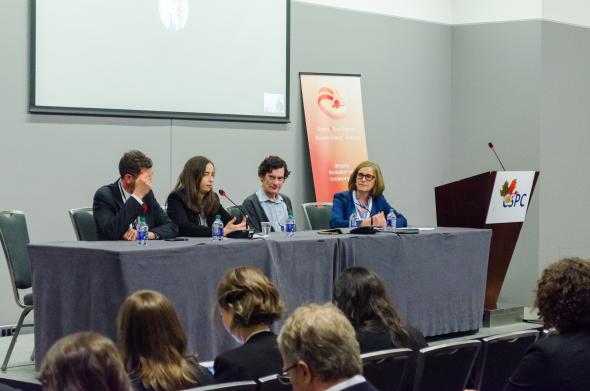
Conference Day: Day 3 – November 3rd 2017
Organized by: Shawn McGuirk & Vanessa Sung, Science Policy Exchange
Speakers: Mark Blevis, President and Digital Public Affairs Strategist, Full Duplex Ltd.; Pascal Lapointe, Editor-in-Chief, L’Agence Science Press; Alyssa Lerner, Senior Editor, SciShow; Kirstine Stewart, Chief Strategy Officer, Diply
Moderator: Nora Young, Host, CBC Radio’s Spark
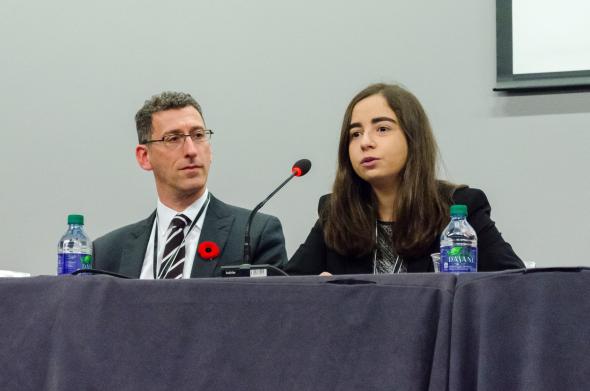
Takeaways and recommendations:
- It is important to develop compelling narratives to capture the attention of those who may not be initially interested in science stories. Emphasize the human dimension to drive the narrative and ignite interest.
- Analogy and metaphor are useful in connecting science to the lives and environment of the audience.
- For audio media, emphasize stories that lend themselves to that format. Social media is a challenge for audio.
- Podcasts have a huge advantage in engaging listeners deeply and in building listener loyalty, engagement and sharing.
- Accuracy is paramount in convincing media consumers that the information they are receiving is correct and trustworthy. There are more than 140 fact checking websites in more than 40 countries. Breaking news is harder to fact check than stories that can be developed over time.
- There will always be people and groups that are unconvinced by scientific facts. For example, climate sceptics usually aren’t swayed by rational argument.
- Science video delivered via online services like YouTube make science more accessible than previously possible with conventional media. Unusual or “weird” science stories can appeal to a broader audience than hard-science stories such as HIV/AIDS or replication of scientific results.
- The explosion of online news and social media has given everyone the opportunity to have a voice, allowing people to generate as well as receive science content. Alternatively, it has led to a proliferation of “fake news”, which can be combatted by using algorithms to weed out erroneous content.
- Social media can open up science conversations to marginalized people, as well as reaching those who often do not stray outside of their self-prescribed media outlets.
- Youth need to learn digital media literacy to discern what is real or fake.
- With the proliferation of information sources, it has become more difficult to generate interest and enthusiasm in science stories. But there will always be a core audience that can be enhanced by targeting people that are not aware of your existence.
Documents:
CSPC 2017 Takeaway: Media Personalities
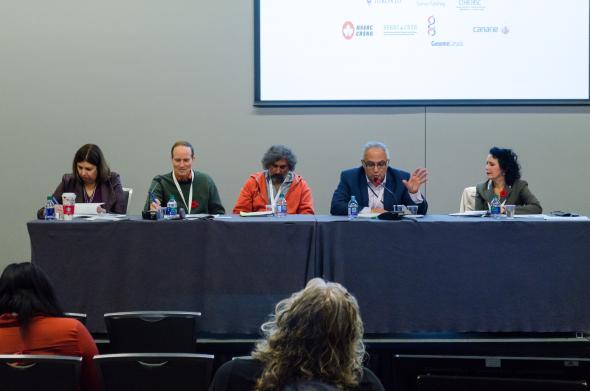
Conference Day: Day 3 – November 3rd 2017
Organized by: Martin Taylor, Canadian Research Data Centre Network (CRDCN)
Speakers: Jane Badets, Assistant Chief Statistician, Social, Health and Labour Field, Statistics Canada; Ümit Kiziltan, Director General, Immigration, Refugee and Citizenship Canada; Ravi Pendakur, Professor of Public and International Affairs, University of Ottawa; Arthur Sweetman, Professor, Department of Economics, McMaster University
Moderator: Dr. Michelle Gauthier, Special Advisor, CRDCN
Takeaways and recommendations:
What we know:
- The foreign born population (i.e. first generation) make up the majority (53%) of STEM graduates with at least a bachelor’s degree between the ages of 24 and 64 in Canada; 72% of people with an engineering and engineering technology major field of study have an immigrant background (first and second generations in Canada combined), while 71% of people with a computer science and mathematics major field of study have an immigrant background. The data source for this information is the 2011 National Household Survey.
- Established Economic Principal Applicants whose highest level of schooling was at least a STEM university bachelor’s degree from a Canadian institution are more likely to be working in STEM jobs at 54% in Canada compared to their Canada born counterparts at 41%. Here the term “established immigrants” is referring to immigrants who received permanent resident status between 1991 and 2000. STEM occupations are those in which a majority of the employed population, between the ages of 25 and 64, are STEM educated. The data source for this information is the 2011 National Household Survey – Immigration Landing File Linkage Database.
- Immigrants make up about 22% of Canadian population yet 35% of Canada Research Chairs.
- Immigrants in STEM used to earn about 20% less than Canadians. That gap has increased to 40%. The gap could have been worse if policies hadn’t been implemented.
- Economic immigrant principal applicants are twice as likely to start knowledge-based businesses.
- Immigrants account for about one third of patents, but one quarter of the population. STEM occupations and training account for most of the ethnic patenting advantage.
- Language skills seem to play a crucial role in allowing STEM skills to be of value in the Canadian labour market.
- Canada, unlike the U.S., hasn’t made the physical capital investments required to make STEM immigrants productive in the workforce.
Policy lessons learned:
- The Express Entry Program, launched in 2015, is an example of policy based on strong evidence of what works in determinants of success (e.g. earnings; more STEM immigrants working in STEM jobs).
- Patents as a proxy for immigration: Immigrants produce far more patents in the US than in Canada; Canada’s “points system” may be hindering productive/innovation employer-employee STEM matches (Express Entry program could help).
- The economic integration of immigrants is probably one of Canada’s most evidence-informed large-scale national economic and social policies.
- Canada needs to do more to improve literacy, communications and numeracy skills among immigrants; such foundational skills have significant rates of return in the labour market.
Producing better data:
- Immigration, Refugee and Citizenship Canada is making more of its internal data available to Canada’s scientific community in partnership with StatsCan, CRDCN and the policy community, and looking at ways to make it more accessible (e.g. virtual remote access).
- For the first time, immigrant category of admission has been added to the 2016 Census which will allow for a deeper dive into the topics such as the retention and outcomes of recent immigrants and refugees to Canada.
- Immigration data are increasingly being linked and integrated with other data sources, including census data, educational data, tax returns, and labour force survey and provincial health databases. This provides a more complete picture of how, for example, students studying in STEM do in the labour market after graduating and over time. Even more data integration is needed to answer key policy questions.
- Popular memes that conflict with evidence tend to take priority in policy. “We need to think seriously about knowledge transfer.”
- There are pockets of remarkably deep knowledge within the civil service, as well as the policy and academic communities but this knowledge has limited influence on popular discourse. (e.g. the positive effect of immigration on the structure of an aging population).
- Economists and social scientists tend to study the same issues over and over while leaving many policy relevant topics unexplored; the academic community could do better.
What we don’t know:
- There is a need for more qualitative data.
- There are social determinants that are not tracked that could help explain why wage gaps are higher for immigrants compared to visible minorities (e.g. where they were raised and schooled; loss of social and professional networks, discrimination based on skin colour).
- There is still much we don’t know, but they tend to be the hard questions, such as:
- Economic and fiscal impact of immigration. Causal impact on GDP per capita is unclear.
- Does immigration have small positive or small negative effects
- What would Canada look like if we had a different immigration policy?
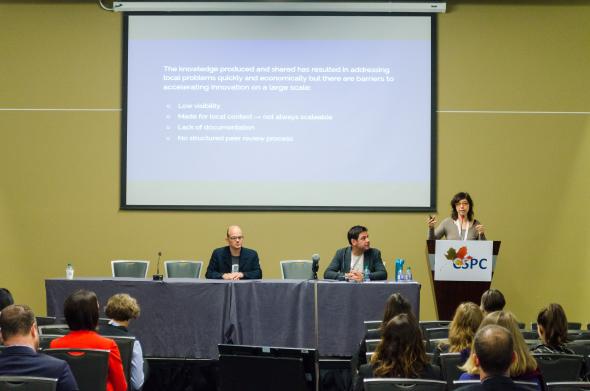
Conference Day: Day 3 – November 3rd 2017
Organized by: Tiberius Brastaviceanu, ACES-CAKE
Speakers: Fabio Balli, Co-founder, Breathing Games; Maria Frangos, Affiliate & UX Product Designer (Core Development Team member), SENSORICA and Breathing Games
Moderator: Tiberius Brastaviceanu, Co-founder, SENSORICA
Takeaways and recommendations:
- The open science and innovation movement explores and prototypes new practices and methods of producing, diffusing and using knowledge. Initiatives like Open Access, Open Data and Open Labs strive for a more open, transparent and collaborative scientific process, both inside and outside of academic research (i.e. from citizen scientists).
- Open innovation is more than open science. It also includes:
- Open and free publications
- Crowdsourcing and crowdfunding science
- Open and connected academic labs
- Shareable equipment and instruments that allow socialization of work
- IT infrastructures for open collaborative work
Open innovation networks
- Open innovation networks like SENSORICA tackle complex problems through interdisciplinary teams, accelerate innovation practices, build bridges between stakeholders and connect with communities on the ground.
- Knowledge produced and shared through these networks has been used to address local problems quickly and economically.
We must engage the crowd
- The crowd (i.e. people) is the third pillar in scientific development and open innovation. Canada should encourage public-private-people (crowd) partnerships.
- The “old” model (academia) did research and found solutions. The new model (crowd) has become the vehicle for generating new solutions.
- An example is Breathing Games, in which clinicians, designers, patients, etc. come together to create an app that transforms education and treatment into something fun and engaging while providing data back to researchers.
- Bringing the local community into the problem/design/solution process builds empathy and helps researchers more fully understand the issues and problems that community is facing.
The socio-economic benefits of open science and innovation
- A closed, market-driven approach to innovation creates redundancies, is more likely to lead to obsolescence, is exclusionary, creates disparities and does not engage relevant populations. Open, people-centric settings make use of collective intelligence, are more likely to result in uptake by populations and are inclusive and accessible.
- Open science can motivate hospitals and universities to collaborate, and can even allow projects that have been abandoned due to lack of funding to start up again.
- Traditional institutions that connect to or form larger collaborative ecosystems can:
- Cut costs by mutualizing resources
- Increase the speed and the quality of innovation
- Facilitate transactions
- Streamline economic activity and logistics
- Barrier-free access to publications will increase application of research. This allows researchers applying for grants to show the practical application of the research, which increases their likelihood of receiving the grant.
Facilitating and encouraging open science and innovation
- Academics and industry must interact with the crowd and open spaces, and this interaction must be incentivized.
- Look to Europe for models; e.g. public funds for research based on/in interactive open spaces, funding makerspaces. Canada needs to catch up, and to shift its culture to one that embraces these approaches.
- Canada needs to go beyond investing in new technologies and experiment with emerging research methodologies and participatory approaches.
- Ensure there is strong digital infrastructure so that data produced by these open science and innovation collaborations are not lost.
- Implement policies that ensure data can be collectively managed in safe and ethical ways.
- Redesign scientific instruments to be easily shared by many people (i.e. not easily broken or disrupted), and make them connected (i.e. so they can directly share data).
- There should be a federation that connects the various makerspaces, hakerspaces, etc. It should work to build the ecosystem, bring in industry and academics, and create a robust and communal IT infrastructure. This will help:
- Ensure a unified experience across various spaces.
- Map and increase the visibility of resources.
- Encourage spaces to collaborate by implementing shared governance and oversight, increasing their resources if they participate, and allowing to access communal infrastructure (right now, many spaces operate on membership models and are worried about losing clients to other spaces if they collaborate).
- Generate a governance layer that helps create shared expectations/understanding of the rules of open science and innovation, and accountability if those rules are not followed.
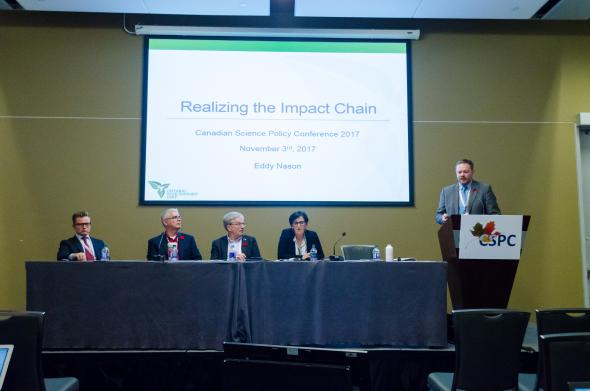
Conference Day: Day 3 – November 3rd 2017
Organized by: Eddy Nason, Ontario SPOR Support Unit
Speakers: Jane Barratt, Secretary General, International Federation on Ageing; David Budtz Pedersen, Professor and Co-Director of the Humanomics Research Centre, Aalborg University; David Phipps, Executive Director, Research & Innovation Services, Division of Vice-President Research & Innovation / Office of Research Services, York University; Rémi Quirion, Chief Scientist of Quebec
Moderator: Eddy Nason, Assistant Director, Ontario SPOR SUPPORT Unit
Takeaways and recommendations:
- Several organizations in Canada have been successful in operationalizing impact assessments (e.g. Alberta Innovates, Canadian Institutes of Health Research, Canadian Health Services and Policy Research Alliance), but it is not evenly applied across Canada. While the grassroots community is strong, a high-level policy or mandate is needed to link the various efforts.
- The new Canada Research Coordinating Committee, which will coordinate activities among the three federal granting agencies, should be mandated to develop standardized impact assessment tools (as is done in the UK).
- Canada has shown leadership in building capacity in this field by teaming up with the UK and Spain to launch the International School on Research Impact Assessment.
- International School on Research Impact Assessment (ISRIA) was founded by Paula Governments around the world continue to make decisions in the absence of good evidence. (e.g. Canada lacks adequate surveillance systems and registers to measure health impact of vaccines,)
Measure impact through the eyes of the end user
- Researchers need to consider the ultimate impact their work will have on average people. “Try looking at the potential impact of your research through the lens of the end user.”
- The road to impact starts with engagement with stakeholders (e.g. policy/practice partner/end users) to identify the research challenge and goals, design the project, disseminate and implement the results, and evaluate the impacts.
- What matters to an academic (e.g. papers, conferences, successive grants) doesn’t matter to the end user. Disseminate research results in ways that end users can use. (e.g. the Social ABCs manual for parents and caregivers resulted in a 45% improvement in responsiveness of autism children. The program is now scaling to other cities.)
- Think about impact in a way that tells a coherent story that is convincing for a policymaker, not just to get the next grant.
- Academia, industry and government should work together to create solutions that translate evidence into action.
- An example of data that matters to society but isn’t captured by research is in the area of “population aging”. Yet, there are very little data that are desegregated beyond age 75. That contributes to age discrimination and age stereotypical behaviour because we don’t have the data necessary to develop informed policy. (e.g. the World Health Organization’s Global Strategy and Action Plan on ageing and health, of which Canada is a signatory.)
UK’s approach to measuring impact
- One delegate described the UK’s Research Excellence Framework (REF), it as “the most operational impact tool in the world”. 20% of the score from the REF is based on “impact”.
- The REF defines impact as “an effect on, change or benefit to the economy, society, culture, public policy or services, health, the environment or quality of life, beyond academia”.
- Impacts are submitted to the REF as narrative case studies and assessed by a panel of experts.
- A review of the 2014 REF found most case studies were interdisciplinary research; it also identified over 3,700 unique pathways from research to impact.
- All granting councils and most research funders in UK use Researchfish®, a research impact assessment platform that measures impact and accountability; researchers are required to do this assessment at the end of their project, and again 2-5 years later.
- A portfolio of research is more usefully assessed than individual projects.
- There are still challenges to overcome:
- How to measure and assess interdisciplinary research.
- Understanding how impacts came about from retrospective analyses – “you don’t get involved in discussions as they happen”.
Quebec’s approach to measuring impact
- Quebec’s efforts in this area are “still a work in progress”.
- When it comes to outputs and outcomes, elected officials are as interested in qualitative data as quantitative data.
- The most important metric for governments is jobs.
- Quebec’s three research funding organizations are committed knowledge mobilization, and KM will be a major priority in future plans and activities aimed at elected officials, high-level officials and civil society.
- Peer review and promotions/tenure in academia need to recognize and reward KM, which includes interdisciplinary research.
- Fonds de Recherche du Québec (FRQ) recently launched AUDACE, a funding opportunity for intersectoral, innovative and high-risk research that includes a KM requirement.
- KM should include efforts to increase critical thinking and science literacy. (e.g. FRQ holds science breakfasts for elected officials, and supports Détecteur de rumeurs, a fact-checking website developed by the Agence Science-Presse.)
Europe’s approach to measuring impact
- There is no single definition of impact.
- The impact “landscape” in Europe is divided primarily by an interest in academic impact and use of traditional metrics (e.g. bibliometrics, citation levels). But there is emerging interest in social impacts and a growing need for data on these impacts.
- Literature review revealed a strong distinction between focusing on “ex-ante” drivers of impact (the impacts anticipated in a grant application) and “ex-post” drivers (post research evaluation).
- Increasingly grant applications to funders like the European Research Council are being evaluated on criteria related to knowledge mobilization, knowledge transfer and broader societal impact, in addition to traditional metrics.
- While several reports have examined responsible research, social scientific responsibility and responsible metrics, a discussion is needed on responsible impact.
- There are no off-the-shelf metrics that can capture the full impact of research. Instead, we have to develop indicators “in the wild”, drawing on multiple pathways and data sources (e.g. policy, media, cultural, health interactions).
- The “Responsible Impact” project is examining the type of impacts being commissioned by granting councils and foundations at the ex-ante level, and how research is measured at the ex-post level. (Principal investigator is David Budtz Pedersen)
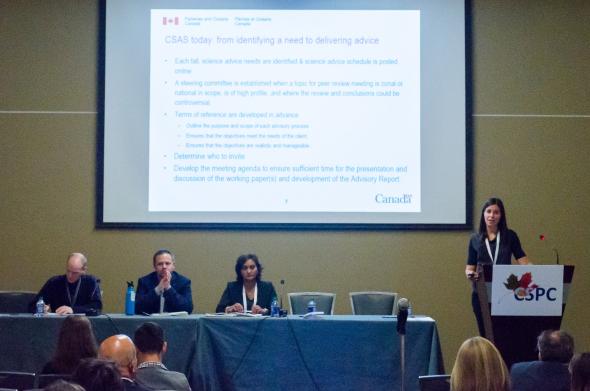
Conference Day: Day 3 – November 3rd 2017
Organized by: Sophie Foster, Fisheries and Oceans, Ottawa
Speakers: Steven Cooke, Professor, Canada Research Chair at Carleton University; Suzuette S. Soomai, Postdoctoral Fellow, Dalhousie University; Nicholas Winfield, Director General, Ecosystems Management, Ecosystems and Fisheries Management, Department of Fisheries and Oceans, Canada
Moderator: Sophie Foster, Acting Director, Canadian Science Advisory Secretariat, Fisheries and Oceans Canada, Ottawa
Takeaways and recommendations:
- The Canadian Science Advisory Secretariat (CSAS) process is the mechanism by which Fisheries and Ocean Canada (DFO) provides peer-reviewed science advice that is used by DFO and made available to the public.
- The CSAS process informs most advice provided to the minister on key issues.
- The CSAS process is effective because it produces credible, relevant, and legitimate information.
- Studies of how information flows within organizations should continue to help organizations evaluate or modify practices to increase the credibility, relevance and legitimacy of the information they produce.
- The science community can organize around upcoming problems to produce evidence for use in the CSAS process.
- DFO does not work in a world of absolute certainties: science-based evidence is one input in the decision-making process.
- Funding could be made available to researchers for conducting research and producing research documents for use in the CSAS process.
- Researchers can use CSAS documents, which outline uncertainties and gaps in knowledge, to justify future funding.
- Use in the CSAS process is a clear demonstration of research impact.
- External experts could come to the process earlier to help define the question and support the strategy for collecting research evidence.
- Systematic reviews could be incorporated into the CSAS process, helping to make the process comparable and reproducible.
Documents:
CSPC 2017 Takeaway: Fisheries
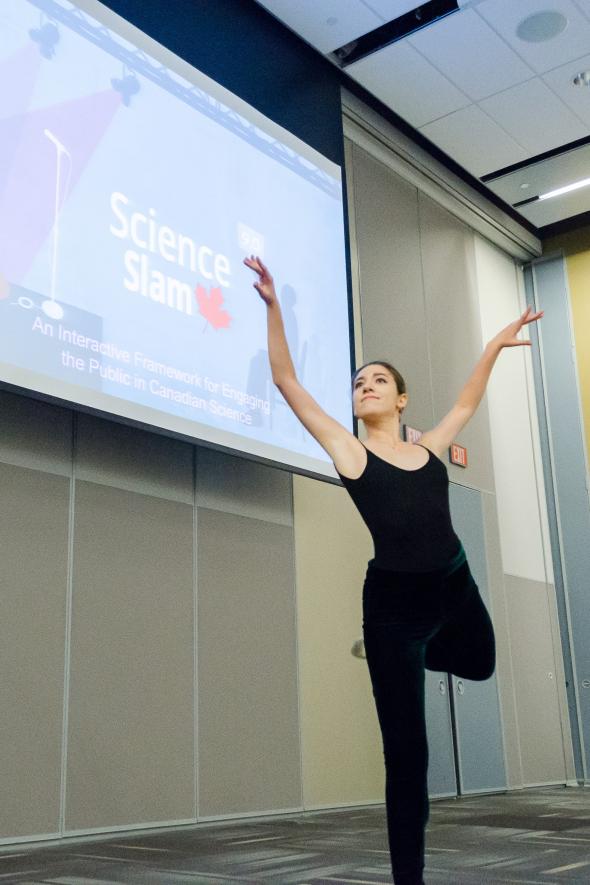
Conference Day: Day 3 – November 3rd 2017
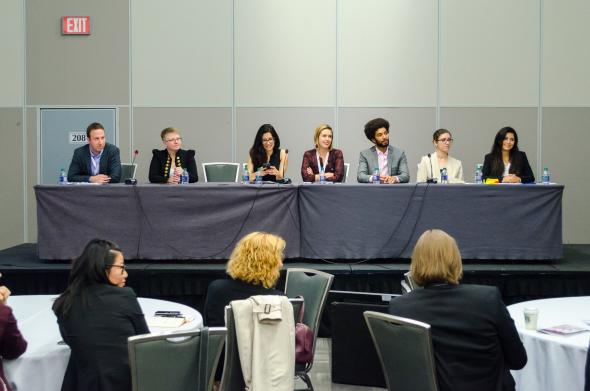
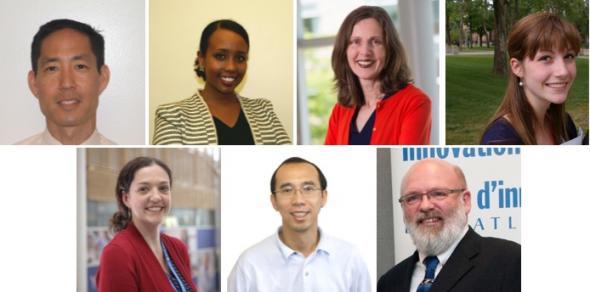
Conference Day: Day 3 – November 3rd 2017
Organized by: CSPC
Speakers: Kei Koizumi, Visiting Scholar in Science Policy, American Association for the Advancement of Science (AAAS); Mahlet N. Mesfin, Deputy Director, Center for Science Diplomacy, AAAS; Nicole Mahoney, Director, Global Regulatory Policy, Merck; Melisssa Mathers, Project Coordinator, Let’s Talk Science; Kelly Cobey, Senior Clinical Research Associate, The Ottawa Hospital; Raymond Ng, Director, Data Science Institute, Professor, Computer Science, UBC; Mark Leggott, Executive Director, Research Data Canada
Takeaways and recommendations:
- Lessons learned from the U.S. White House on using science to meet policy challenges:
- Close links between the science advisor and president ensured the president received timely advice on the latest research.
- A scientific advisor must be able to translate scientific advice into policy language.
- Science rarely gives the full policy solution.
- Recommendations from the AAAS report, Connecting Scientists to Policy Around the World:
- Cultivate and connect boundary-spanning STEM leaders around the world to engage at the science-policy interface,
- Communicate with the public the applications of science and how they serve society, and
- Facilitate knowledge sharing and collaboration.
3. Global perspectives on antimicrobial resistance (AMR) innovation: what does this mean for Canada?
- Policy leaders recognize that incentives will be need to drive innovation to address AMR.
- Ways Canada can be a leader in AMR: develop pathways for development/regulatory approval of new products; create special designations for priority antimicrobials with expedited development and approval pathways; collaborate with global regulators; and support scientific leadership on development pathways for alternative approaches to address bacterial infections.
- Canada will be the G7 president in 2018: continue momentum on AMR and move into action.
- Breaking down barriers for science outreach:
- Simplify protocols and procedures for student involvement in outreach activities.
- Be vocal in praising outreach initiatives.
- Avocate for rewarding researchers and students who participate in science outreach.
- How to ensure the transparency of scientific study designs, their conduct and reporting:
- Solutions for becoming more transparent and accountable in the scientific process: register research programs (addresses publication bias and selective outcome reporting), set reporting guidelines, and establish evidence-based and explicit scientific processes.
- Research results need to be reported in a timely manner, without undue restriction.
- Data science and social implications:
- Better tools need to be developed for open data management.
- Sensitive individual data must be linked effectively to open data.
- Biases embedded in data collections must be considered.
- Smart governance and the exploitation of diversity can be provided by combining the perspectives of data science and social science.
- Open Science: The new normal for knowledge dissemination:
- Research Data Canada works with stakeholders to ensure research data is re-usable in support of innovation that benefits all Canadians.
- A new ecosystem is being created by research communities based on past data.
- “A closed book is but a block of wood.”
Documents:
CSPC 2017 Takeaway: Short Talk Series
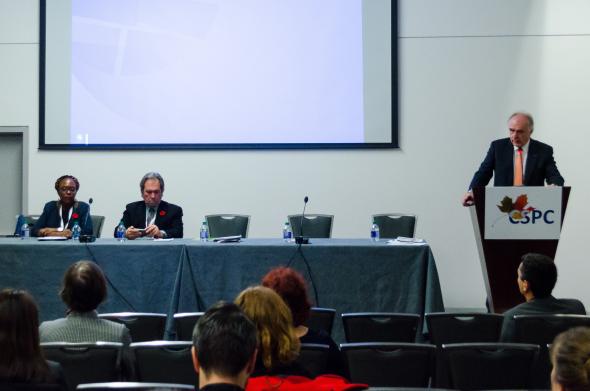
Conference Day: Day 3 – November 3rd 2017
Organized by: Daryl Copeland, CGAI and U of M CERIUM and Mehrdad Hariri, Canadian Science Policy Centre
Panelists: Daryl Copeland, Senior Fellow, Canadian Global Affairs Institute and Policy Fellow at the University of Montreal’s Centre for International Studies (CERIUM); Paul Dufour, Co-chair, Science Integrity Project and Adjunct Professor, University of Ottawa’s Institute for Science, Society and Policy; Pavel Kabat, Director General and Chief Executive Officer, International Institute for Applied Systems Analysis (IIASA); Chibulu Luo, PhD Candidate, University of Toronto, Department of Civil Engineering.
Moderator: Jane Barratt, Secretary General, International Federation on Ageing
Takeaways and recommendations:
- Canada’s capacity to undertake science diplomacy and international research collaboration suffered greatly during the Harper years, and is now weak compared to most other advanced nations.
- Canada needs a quick win to get back in the game of science diplomacy and international scientific cooperation as it prepares to: hold the G7 Presidency and host the organization’s annual meeting in Spring 2018; mount a campaign for election to the UN Security Council in 2020, and support progress towards achieving the UN’s Sustainable Development Goals.
- To attain these objectives, Canada should rebuild global partnerships and re-establish international research and innovation linkages, for example by be-joining the International Institute for Applied Systems Analysis (IIASA), an organization in which Canada was a founding member.
- IIASA been effective in addressing wicked, transational issues such as climate change; food and water security; population/migration; management of the global commons; and sustainable energy policy.
- Global Affairs Canada’s science diplomacy and science policy capacity needs to be strengthened and the department should be tasked with developing an international science strategy.
- Bridge building between nations is particularly relevant in the face of challenges such as global power shift, asymmetrical globalization, rising populist sentiment, Brexit, the widening economic and digital divides and an unpredictable isolationist U.S. administration.
- The federal government’s strong expressions of support for evidence-based policy-making, science and research have not yet been matched with financial reinvestment or substantive action.
- The soft power of science diplomacy can bring researchers together between countries that are otherwise unreconciled, or even hostile towards one another, particularly during crises, or when regular channels of political communication are strained or non-existent.
- If properly planned, resourced and equipped, Canada can advance its interests, promote its values, contribute to development, peace and security, and play an important role in bringing greater ambition, diversity, and geo-political balance to the internationalization of science.
Documents:
CSPC 2017 Takeaway: Internationalization
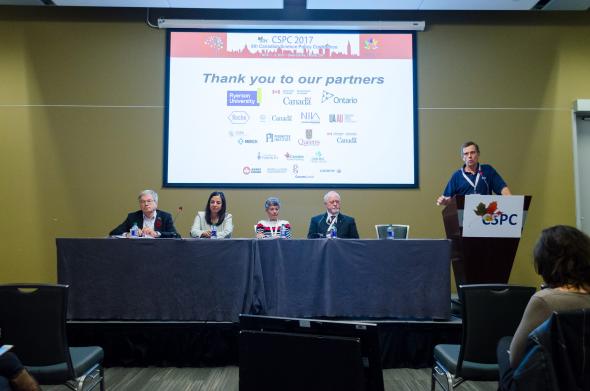
Conference Day: Day 3 – November 3rd 2017
Organized by: Arij Al Chawaf, Structural Genomics Consortium and Annabel Seyller, Tanenbaum Open Science Institute at The Montreal Neurological Institute
Speakers: Elizabeth Edwards, Professor, Department of Chemical Engineering and Applied Chemistry, and Cell and Systems Biology, University of Toronto; Lizabeth Leveille, Associate Vice President and Head, Boston Innovation Hub BD&L, Merck Research Laboratories; Dr. Rémi Quirion, Chief Scientist of Quebec; Guy Rouleau, Chair of the Department of Neurology and Neurosurgery, McGill University
Moderator: Aled Edwards, CEO, Structural Genomics Consortium
Takeaways and recommendations:
Open science is economically beneficial
- People often intuitively feel that open science is socially beneficially but many don’t realize that it is also good for business.
- There is no evidence that patents lead to innovation, unless “number of patents” is a legitimate metric for innovation.
- Open science builds trust between industry and academia; it creates an opportunity for more brains to work on a problem; it helps data be more reproducible; and it allows knowledge to be rapidly taken up by a variety of industry players.
How can Canada lead and create impact from Open Science?
- Canada is already leading in many areas of open science.
- Open science is a significant cultural shift for people in academia and industry; government needs to promote and reward it.
- Subsidize researchers who want to publish in open access journals.
- Government should fund science for the betterment of humanity, not for economic development.
- Reconsider the emphasis research grants place on patent strength.
Working together means finding solutions faster
- Industry should use open science to collaborate on problems they cannot solve on their own.
- Academics are incentivized to innovate and there is less emphasis on reproducibility as industry would define it. Working together with industry strikes a good balance.
- Open science is particularly useful for rare diseases no one is investigating; it’s important for industry to get involved because of their expertise in drug development.
Documents:
CSPC 2017 Takeaway: Benefits of Open Science
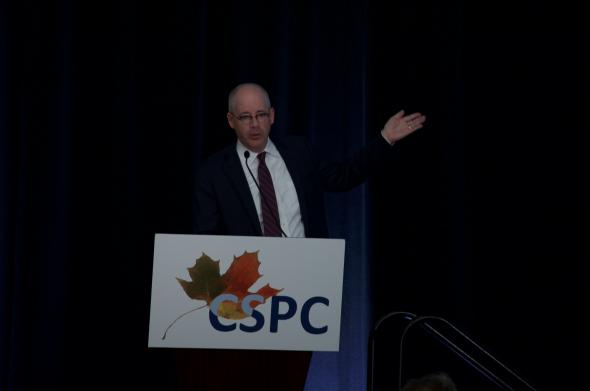
Conference Day: Day 3 – November 3rd 2017
Organized by: National Research Council of Canada
Speaker: Iain Stewart, President, National Research Council (NRC)
Takeaways and recommendations:
The challenges
- Government labs and academia have different cultures and it’s not always clear how they can work together.
- Collaborations between government labs and academia face legal barriers such as the Financial Administration Act, which makes it difficult for the research granting councils to fund academic teams that include government researchers. (The Office of the Comptroller General has proposed a solution that is currently being reviewed internally.)
- Government has different intellectual property regimes from universities, and even among universities there is no standardization. The NRC is currently addressing this challenge by developing standardized IP models that will make such collaborations easier.
- Governments generally have tighter security policies (e.g. secure access to buildings) which academic partners find onerous.
- The NRC’s need to focus on cost recovery has resulted in fewer universities using its facilities. In response, the NRC is looking to reduce the fees it charges to academia.
- Government labs and academia have different systems for terms of employment (e.g. different promotion mechanisms, and no sabbaticals in government) which can be a barrier to collaboration.
The opportunities
- Government labs, many of which already collaborate with industry and academia, need to be part of the solution to Canada’s innovation challenges by providing the “connective tissue” that matches public sector assets with private sector needs.
- Government labs have many assets that could be leveraged with academia to incent more public-private research collaborations. These include: long-term mandates, sustainable funding, highly qualified experts and large facilities.
- The NRC has buildings on campuses across Canada but more needs to be done to strengthen their research relationship with that university.
- There is an opportunity for the NRC to change its large-scale programs, which favour joint projects between NRC scientists and industry, to include more collaboration with academia.
- The NRC should be doing large-scale programs that respond to the government’s priorities (e.g. superclusters).
- Renewed NRC emphasis on exploratory research underpinning foundational, disruptive technologies (e.g. quantum computing) offer a powerful attraction to academic researchers.
- There is a need to take a shared approach (e.g. shared management, locations and teams) between the sophisticated equipment in government labs and research infrastructure in universities.
- NRC researchers should be adjunct professors at universities, and the NRC should have more graduate students and post-doctoral fellows working at its facilities.
Documents:
CSPC 2017 Takeaway: NRC
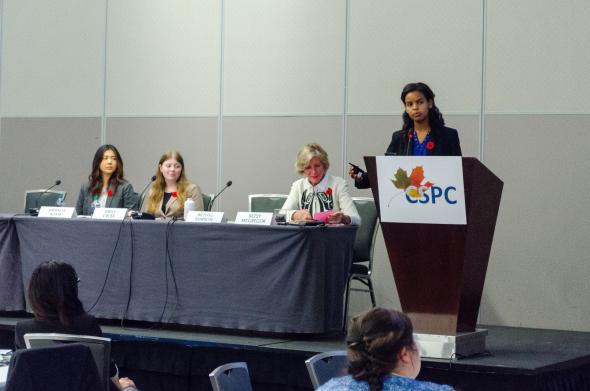
Conference Day: Day 3 – November 3rd 2017
Organized by: Teddy Katz and Betsy McGregor, SHAD
Speakers: Amanda Adam, High School Student, Member of 771 All Girls Robotics Team, Student Leader of her school’s STEMR Department, St. Mildred’s- Lightbourn School; Winnica Beltrano, University Student, Canada-Wide Science Fair Award Winner, University of Calgary; Paulina Cameron, Expert Panel on Youth Employment, Director, Futurpreneur BC; Emily Cross, High School Student, Canada-Wide Science Fair Award Winner; Erin Engelhardt, Program Director of SHAD, Carleton University; Sarah Gauthier, Assistant Professor, University of Saskatchewan; Melanie Martin, Professor of Physics, University of Winnipeg; Bethel Samson, International Baccalaureate Program High School Student – Summer intern, Megbare Senay Hospital and Addis Ababa University of Pharmacy (SHAD 2017)
Moderator: Betsy McGregor, Founder and Facilitator (Global Leader in Advancement of Youth and Women), McGregor Leadership
Takeaways and recommendations:
Support under-represented groups in school
- Support and/or create a national STEM mentorship program for girls and Indigenous youth.
- Fund more programs that target underrepresented groups like immigrants, refugees, Indigenous peoples, and individuals who reside in rural or isolated areas.
- Consider the unique barriers for those in rural and isolated communities, such as lack of access to equipment, networks, and fieldwork, and create solutions (e.g. travel bursaries that help fund girls/underrepresented groups from rural communities to access opportunities in larger city centres).
- Address the federal underfunding of First Nations education.
- Build into the curriculum connections between classic Western systems and traditional Indigenous knowledge.
- When creating STEM programs in any community, particularly Indigenous communities, work with people from that community to develop the programming and ensure it is rooted in local knowledge.
- Add more women and women of colour in STEM-related places like displays on school walls and in textbooks, as well as more broadly on Google, government websites, etc.
- Teach young girls that it is okay to fail and to let people see your mistakes. (i.e. the SHAD program allows youth to fail in safety.)
- The Canadian government should create and run a networking app to connect young girls to STEM professionals and mentors.
Combat the brain drain
- Women who do not feel welcome in Canada or do not see equal opportunities here will leave to start their businesses/careers or do research elsewhere.
- Continue to push for gender equity in the Canada Research Chairs and Canada Excellence Research Chairs.
- The gender equity statement required by nominating universities for the Canada 150 chairs is a good step.
- Bring back scholarship programs targeting women and under-represented groups that were effective (e.g. NSERC University Faculty Award, NSERC USRA program for women, NRC Women in Engineering and Science program, etc.) and/or create more.
- Continue to fund proven programs (e.g. SHAD, Let’s Talk Science, Actua, NSERC regional women’s chairs, etc.).
- Review and fix gender inequalities for research opportunities from tri-council and other government funding agencies including:
- Put more women on review committees (with consideration given for childcare needs).
- Educate reviewers on gender bias.
- Consider the gender diversity and commitment to EDI (equity, diversity and inclusion) of the institutions applying.
- Create more funding/grants that target under-represented groups.
- Proactive government initiatives have succeeded in increasing the number of women on boards or as CEOs; more of these initiatives are needed.
- Provide tax incentives for:
- Companies hiring and/or training female engineers, technicians and scientists.
- Organizations promoting women to higher paid positions in STEM fields.
- Provide critical growth capital dedicated to women.
- Provide access to the global market for women; ensure trade mission delegations are 50% women.
Modernize child-rearing expectations and support
- Through tri-council policy, students can now get maternity/paternity leave – this is a positive step.
- Modernize what parental leave looks like. It should be more flexible in supporting entrepreneurs who don’t have the social security networks of those working in institutions.
- Reduce stigma on being a stay-at-home father. Encourage and be open about male partners taking on more of the child-rearing role.
- Empower men to share the family burden. Start by teaching boys and girls that child-rearing should be every parent’s responsibility.
Push for cultural change
- It should not be on women or those from under-represented groups to break down barriers. It is the responsibility of the people with the privilege to lower those barriers.
- If you see an event with less than 50% female speakers, send the organizers a list of women to consider.
- Canadians should celebrate science like we celebrate sports.
- The government should create and/or support innovations that encourage women to become investors.
Advice for scholars from under-represented groups
- Apply more often for awards and scholarships, be confident, don’t be afraid to ask for nominations or nominate yourself, and don’t let setbacks dissuade you from trying again.
- Establish relationships with mentors who inspire and show what is possible.
- Surround yourself with like-minded and supportive people, and sign up for as many opportunities as you can.
- Women often do not apply for things like conferences, positions, etc. if they do not feel they are 100% qualified – be bold and apply anyway!
- Try and rise above judgment and trust in yourself.
- Encourage the young women in your life to apply for programs like SHAD and nominate them for awards and positions
Documents:
CSPC 2017 Takeaway: Missing Numbers

